History
The Fossil Hill Member was first recognized for its paleontological resources at the end of the 19th century. John Campbell Merriam and Eustace Furlong from the University of California Berkeley led the Saurian Expedition of 1905 to Fossil Hill in the Humboldt Mountains with the intention to search for Ichthyosaur fossils. The expedition was joined by the venerable heiress Annie Alexander who financed the expedition and provided most of the written documentation through journal entries and photographs. [4] The expedition excavated the remains of 25 Triassic Ichthyosaurs, many of which were collected and shipped back to Berkeley. These skeletons, along with those collected from subsequent expeditions by UC Berkeley in the early 20th century, were the most complete Ichthyosaur specimens from North America at the time, and Merriam's study of these fossils provided some of the earliest knowledge on early ichthyosaur evolution.
In the latter half of the 20th century, the section of Fossil Hill Member outcropping in the Augusta Mountains was identified for its ammonoid record to be used in biostratigraphic definition and correlation of Triassic rocks. [5] Field observations of vertebrate fossils in the Augusta Mountains drew the attention of paleontologist Martin Sander who has led numerous teams to collect marine reptile fossils including specimens representing 7 new species. Paleontological fieldwork and research in the Augusta Mountains is ongoing.













